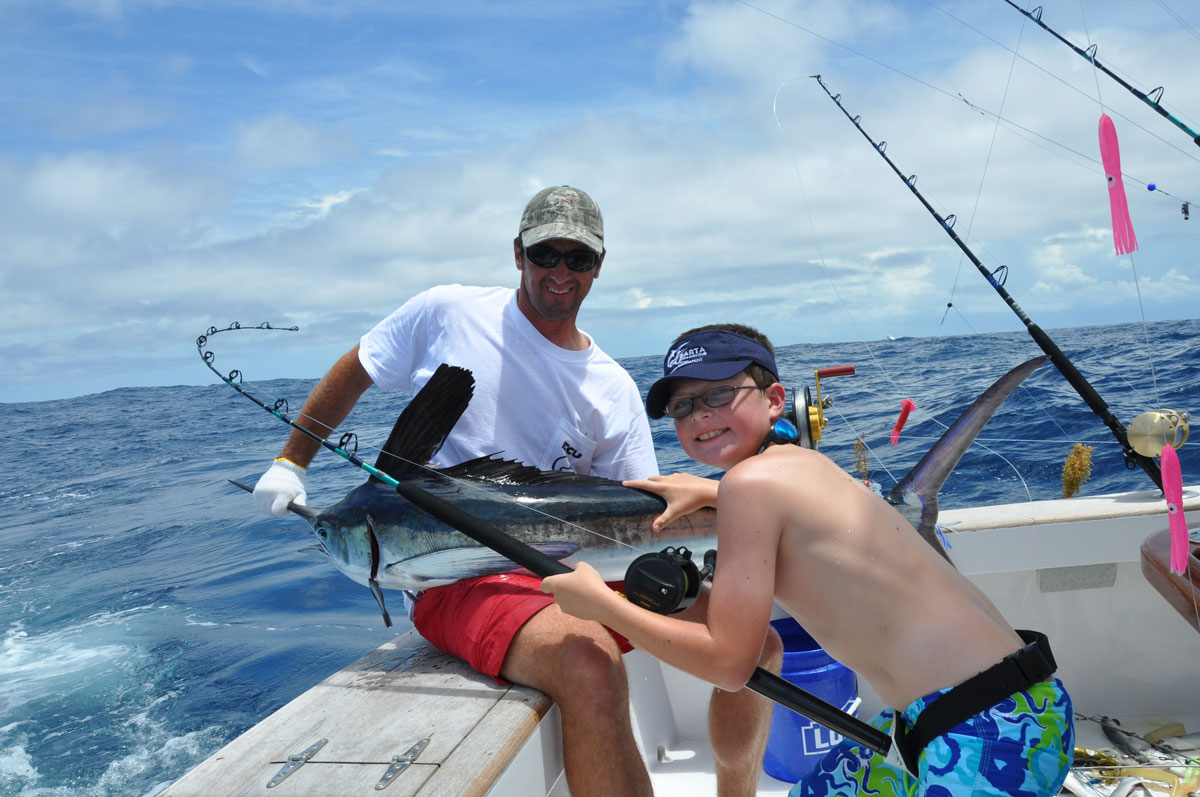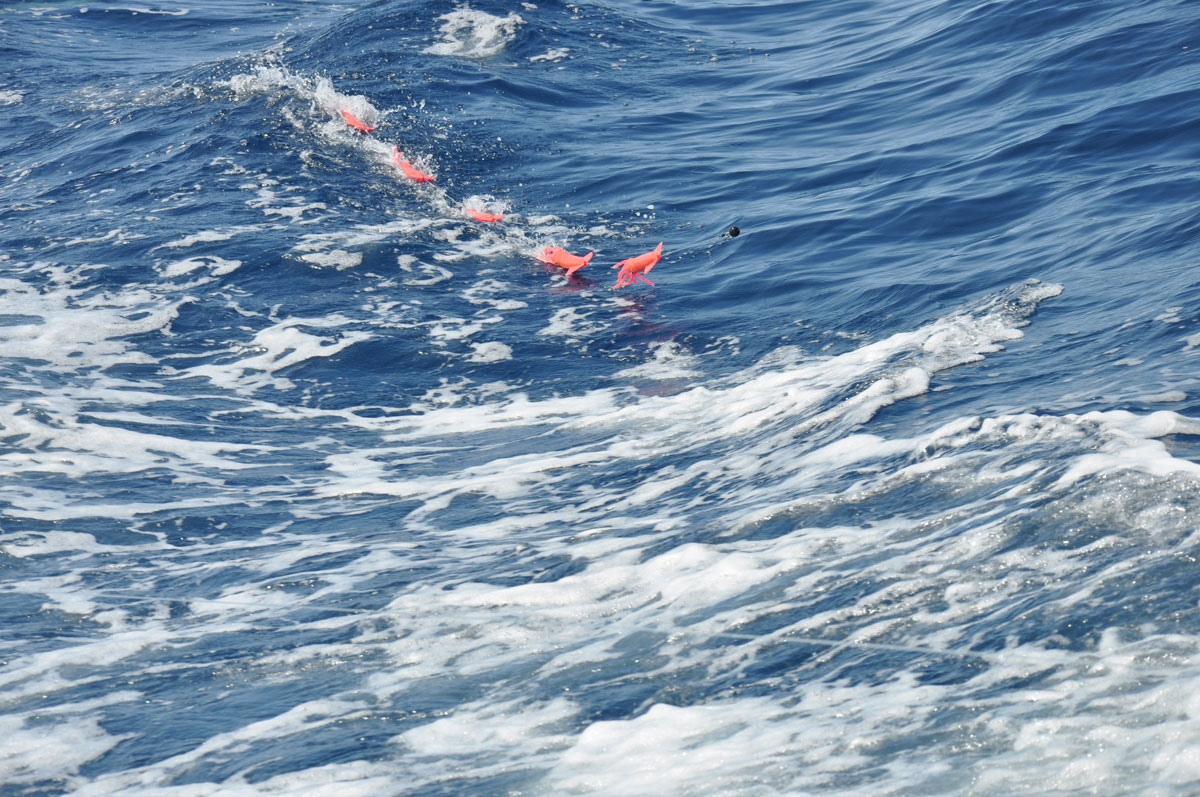
Learn how to target and catch white marlin at the peak of their migration through North Carolina waters.
They used to be known as the dog days of summer, but from Oregon Inlet to Hatteras and Cape Lookout, offshore anglers have been spoiled by a white marlin bite between July and September that is only getting better each year.
Like their sailfish and blue marlin counterparts, white marlin are transient inhabitants of offshore bluewaters. They feed. They school. They dance on the surface, flip, shake and twist, giving hooked-anglers pure adrenaline. In recent years, fishermen have found a good showing of white marlin during the transition period when the blue marlin bite slows and before sailfish have fully arrived.
From Oregon Inlet, boats concentrate on blended water with temperature changes in the area to the southeast known as the Point. From Hatteras, boats sometimes whites in nearshore waters no more than 10 miles off the beach, if the water turns hot, or feeding in healthy numbers around the Rock Pile due south of Hatteras Inlet. From Morehead City, boats generally find whites in areas north of the Big Rock.
In 2013, the bite from Oregon Inlet was epic, with more than 1,500 white marlin releases at the peak of the season. Last July, during the Barta Billfish Tournament, anglers found an epic bite that lasted for an hour, with more than 25 billfish, mostly whites, occurring.
“I’ve never seen anything like it,” said Capt. Alan Willis of Morehead City’s Carolina Lady, which won the Barta event.
Fishing for white marlin is more of a passive approach compared to blue marlin. By nature, white marlins are finicky eaters, but they are also pesky and will school heavily in an area when bait is prevalent. The approach for locating white marlins is finding blended water, with obvious signs of bait such as flying fish, schooled baitfish on the water or smaller, bailer-class dolphin. More important is locating these conditions in water that does not flow with current.
Trolling speeds are generally slower than for blue marlin. Through trolling patterns vary from boat to angler, traditionally boats pull a daisy chain with common squid colors from outriggers or a single daisy chain with a dredge teaser system just off the corner of the transom riding 3 to 5 feet beneath the surface.
Lure presentations for white marlins range from small to medium soft-head baits, with the hook running either up or down. From one wave back from the teaser or behind the dredge, lures aid by running as hooked teasers in attracting fish.
“I probably raise more marlin, especially white marlin, off pulling lures as teasers than anything else, switching them off to a dink bait on the raise,” said Capt. David Wilson on the Godspeed out of Hatteras.
That leads to the reason white marlin are effectively hooked and appear to actually prefer small ballyhoo rigged in traditional circle-hook fashion. In a traditional pattern of trolled lures, the most-frequent and effective bite appears to be that of a naked ballyhoo, also known as a dink bait, presented dead center, three waves back from the prop wake. Second in terms of trolled baits that receive the most attention are dink baits trolled from the long outrigger, one or two waves behind the short outrigger lure that follows the teaser.

“Almost every time we will have a billfish follow the lure, especially white marlin and sails, and they immediately switch off to the dink bait,” Wilson said.
While lure and bait presentation are important, one of the factors that anglers must consider when targeting white marlins is proper delivery of bait during the hook-up. While some whites will crash a lure or swallow a dink bait and become hooked on the initial tug, letting them have the baits completely is often required and more effective.
Phil Young of Durham, a seasoned tournament angler, believes the most-important aspect of catching a white marlin is having no tension on the line during the hook-up.
“It’s all about letting the fish feed and swallow; you want that bait to be swallowed by the fish and then retrieve the hook slowly until you become tight with the fish,” Young said.
Important points to keep in mind when deploying dink baits include keeping the reel in free spool without a clicker and twisting the line at the outrigger clip, with the tension as loose as possible, so the bait will swim in the desired location.
“Once the bait clips out, allow it to free spool, walk it to the corner and count six Mississippis before walking the drag forward. When the circle hook embeds, lift the pole only slightly in the opposite direction of the fish,” Young said.
Often, the fish will not hook on the first attempt, and a subsequent feed, by free spool, will incite another bite.
Fishing for white marlin off North Carolina has become a bonus fishery for charter and private boat anglers. The opportunity to experience multiple opportunities with white marlins increases from July through September. Following local fishing reports and monitoring offshore conditions will assist in planning. More importantly is recognizing that white marlins are delicate feeders and need to be fished, accordingly. However, when they school and forge and follow trolled baits, the bite can be as hot as the weather in August.
DESTINATION INFORMATION
HOW TO GET THERE/WHEN TO GO — White marlin show up in the bluewaters off North Carolina’s Outer Banks in July and stay in the area through September, with August and early September being peak times to get double-digit hookups on a single trip. US 64 will bring fishermen to Manteo, then US 12 south to Oregon Inlet and Hatteras, poplar jumping-off points for offshore anglers. Morehead City is another port where boats can target whites. Access it via US 70.
WHEN TO GO — White marlin show up in the bluewaters off North Carolina’s Outer Banks in July and stay in the area through September, with August and early September being peak times to get double-digit hookups on a single trip. US 64 will bring fishermen to Manteo, then US 12 south to Oregon Inlet and Hatteras, poplar jumping-off points for offshore anglers. Morehead City is another port where boats can target whites. Access it via US 70.
BEST TECHNIQUES — Troll a spread of dalsy-chained squid or dink baits — naked ballyhoo on circle hooks. Look for fish in areas without much current where plenty of flying fish and other baitfish are present.
FISHING INFO/GUIDES —Capt. David Wilson, Godspeed Charters, Hatteras, 252-995-3311, www.godspeedcharters.com; Capt. Alan WIllis, Carolina Lady Charters, Morehead City, 252-723-5779, www.carolinalady.com; Capt. Dale Britt, Sensation Sportfishing, Morehead City, www.sensationsportfishing.com; Oregon Inlet Fishing Center, Manteo, 252-441-6301, www.oregon-inlet.com; Hatteras Harbor Marina, Hatteras, 252-986-2166, www.hatterasharbor.com. See also Guides and Charters in Classifieds.
ACCOMMODATIONS — Outer Banks Visitors Bureau, Manteo, 252-473-2138, www.outerbanks.org; Crystal Coast Tourism Authority, Morehead City, 800-786-6962, www.crystalcoastnc.org.
MAPS — Capt. Segull’s Nautical Charts, 888-473-4855, www.captainsegullcharts.com; Sealake Fishing; Guides, 800-411-0185, www.thegoodspots.com; Maps Unique, 910-458-9923, www.mapsunique.com.


